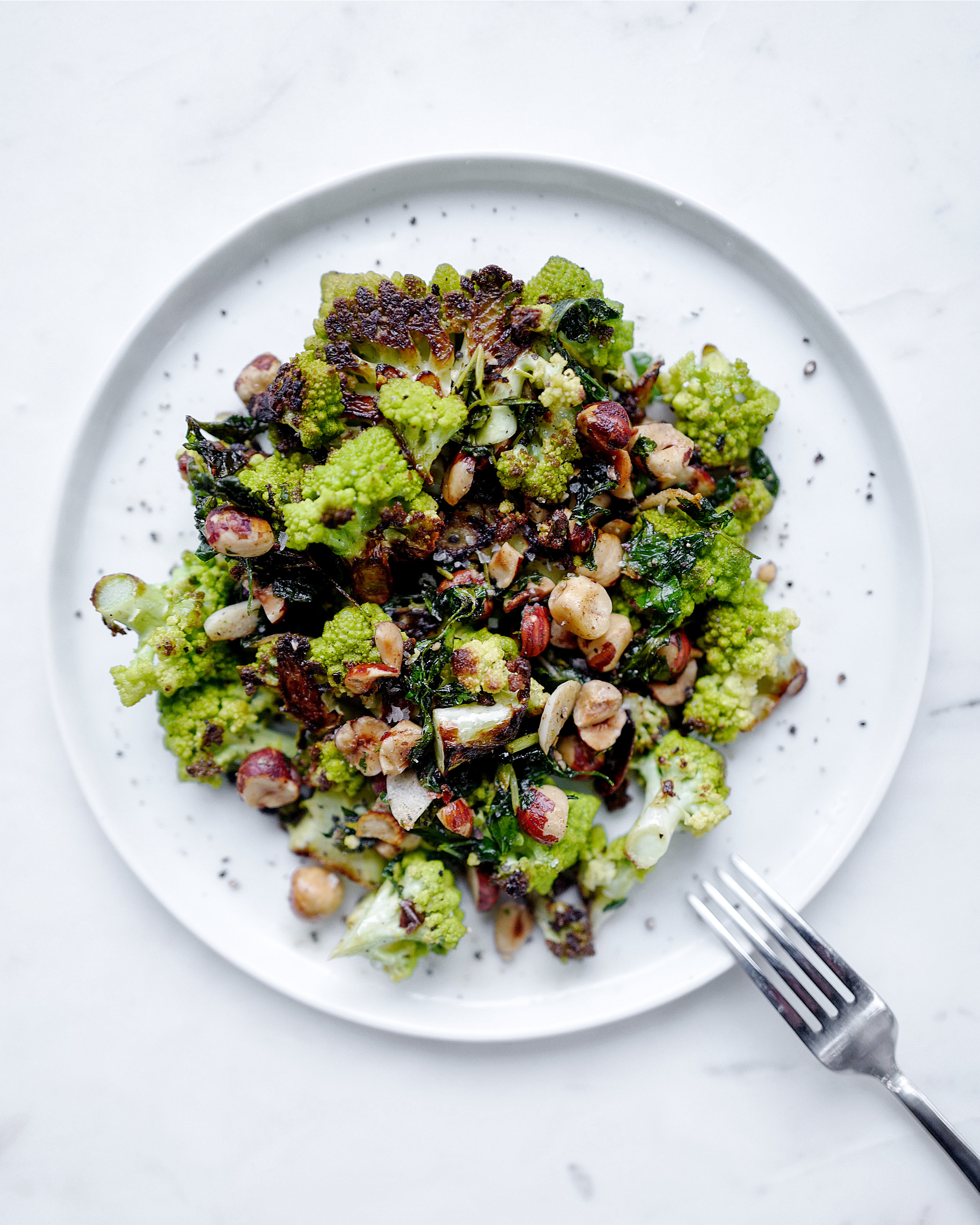carla lalli music's pan-roasted romanesco with hazelnuts and crispy bits
Romanesco is often misunderstood as a broccoflower—or a broccoli and cauliflower hybrid—but it’s actually just a genetic mutation of cauliflower. The mutation is responsible for Romanesco’s bright chartreuse and, unfathomably, the perfect mathematical fractal pattern of each of its florets. EACH FLORET IS A PRECISE GEOMETRICAL MINIATURE OF THE ENTIRE FLOWER.
The crop comes from Italy and dates back to the sixteenth century, but it’s relatively new to the United States. It grows in the fall and winter, with heads growing smaller and smaller into spring. In taste, Romanesco is sweeter and nuttier than its cauliflower sisters. In her new cookbook Where Cooking Begins, Carla Lalli Music pan-roasts Romanesco and tosses it with hazelnuts toasted in hot brown butter. This brings out the natural sweet nuttiness of the vegetable—the Romanesco magically tastes more like itself, but electrified. Adding parsley, a touch of vinegar, and a good amount of lemon keeps things zippy and bright. It’s enough to justify breaking up those beautiful fractal florets. And eating them instead.
Carla lalli Music’s pan-roasted romanesco with hazelnuts and crispy bits
Adapted from Where Cooking Begins by Carla Lalli Music via Bon Appetit.
In her recipe, Carla has you cut the Romanesco into thick steak slabs, pan-roast them in a skillet, and then finish roasting them in a hot oven. I prefer to cut mine into slightly smaller slabs so I can skip the oven altogether. This also allows me to better monitor for doneness—to avoid mush and keep things crispy-crunchy. I’ve included those changes below. In any case, make sure your pan is dry to avoid burning the Romanesco. And taste, taste at every step: the success of this dish depends on perfect cookery and bright seasoning. That said, it won’t work as well on an electric stovetop.
Serves 3-4.
INGREDIENTS
1 medium head Romanesco (about 1 1/2 to 2 lbs), trimmed
Kosher salt
2 tablespoons extra-virgin olive oil, plus more for drizzling
2 tablespoons unsalted butter
1/4 cup skin-on or blanched hazelnuts, coarsely chopped
2 garlic cloves, thinly sliced
1/2 cup chopped parsley
2 teaspoons white wine vinegar
1 lemon
Flaky sea salt (optional)
Freshly ground black pepper
METHOD
Cut Romanesco into 3/4"-thick slabs. The edges will crumble and smaller florets will break away, and that’s good. Break up the bigger slabs a bit with a knife or your hands and cut loose pieces into 1" florets. (The goal is to create some slab pieces that will make maximum contact with the pan and some florets that will get crispy-crunchy.) Season everything with kosher salt.
Heat a large cast-iron skillet over medium-high heat. Add 2 tablespoons olive oil and warm until hot, but not smoking. Add Romanesco, cut side down, and cook until deep golden brown, 3-5 minutes. Stir with tongs or a wooden spoon, adding a drizzle more oil and adjusting the heat as necessary. Cook for another 3-5 minutes, checking for doneness and adjusting seasoning. You want the Romanesco to be tender, but still have some crunch. Avoid mush. (If your pan is too hot and you’re worried about burning, add 1-2 tablespoons of water or chicken stock to prevent scorching.)
Transfer Romanesco to a bowl. Return pan to medium-high heat and add butter, hazelnuts, and garlic, and cook, stirring and adjusting the heat, until butter is browned and hazelnuts are toasted, about 3 minutes. Add parsley and vinegar and stir up any browned bits. Spoon brown butter mixture over Romanesco and toss to combine. Squeeze juice from 1/2 of lemon and toss again. Taste and add more lemon, sea salt or kosher salt, and some freshly ground pepper until Romanesco is bright and zingy and well-salted.

